Setup
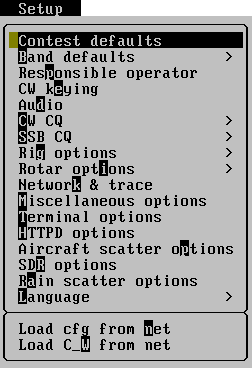
All configuration changes are in memory only until you save configuration.
Contest defaults
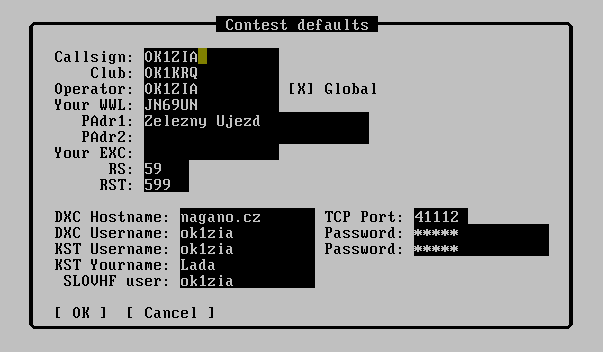
There is possible to set these items in this menu: callsign in contest, club callsign (use only if you can export contest log in EDI format), locator (6 characters), contest QTH (is equal items PAdr1 and PAdr2 in EDI, Optional Exchange and standard proposed reports for SSB and CW.
Band defaults
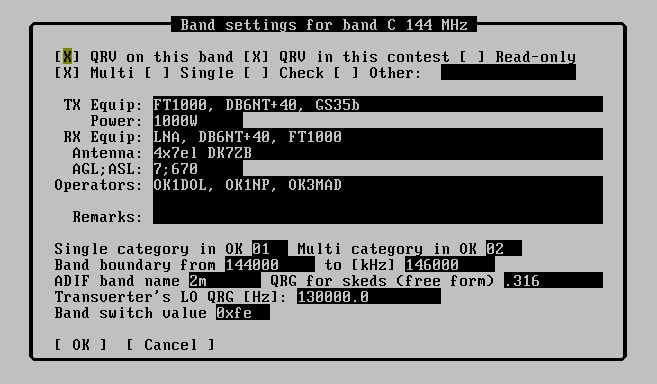
This submenu contains setting of all bands. Active bands (QRV is checked) are separated from other bands. You can take away bands which are never used (as 220MHz in Europe).
You can enter single band setting by pressing ENTER key. Item `QRV on this band' is usually set for all bands where are permit transmittes.
This setting is the only one which must be set. Other items are better set here too but it isn't necessary.
QRV setting in this contest isn't effect on this place. Cathegory can be one of Multi/Single/Check.
TX and RX Equip settings contains describing of equipments. Power is written with units. ASL and AGL means a height between antenna and sea/ground. Inserted values are in meters, delimiter is semicolon.
Fill operator's callsigns into Operators field delimitely by semicolon. It is possible to fill it by Fill operators in menu Contest.
Remark field is assigned for remarks to contest commitee.
Single/Multi cathegories are cathegories valid (probably) only in Czech republic. They are used mostly for EDI files naming.
Band boundaries are entered in kilohertz. At this time are used for DX-cluster spot filtration.
Adif band name is band description used in ADIF format.
QRG for skeds is initial frequency entered by operator to inform other operators about clean/CQ frequency on which they should talk skeds. Format is not limited, you can use any string like ".120" etc.
Transverter's LO QRG is frequency which tucnak adds to frequency read from transceiver's CAT and result shows on the screen: Note some radios support transceiver mode for example radio is tuned on 14 MHz, CAT reports also 14 MHz but transceiver's display shows 144 MHz. LO frequency must be computed by operator, you can use Fix QRG in Edit menu.
Responsible operator
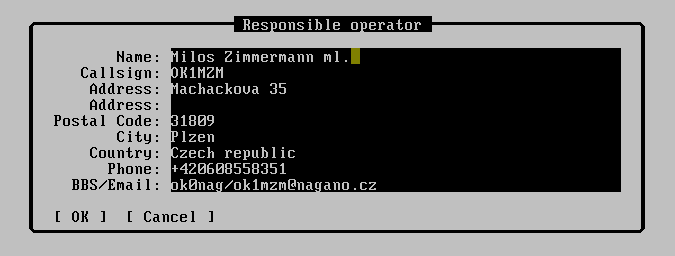
There are set information of responsible operator for communication with contest commitee in this dialogue. All items are in free format and don't need commentary.
CW keying
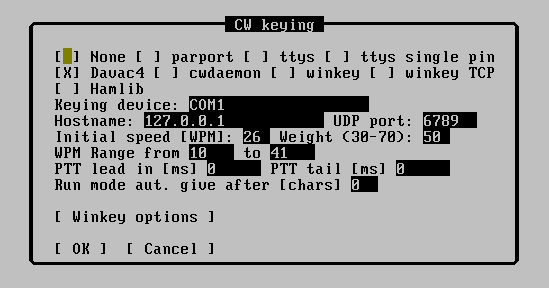
Since 2.0 Tucnak does not use for keying and transmitting CW external program cwdaemon. Its functions are added in Tucnak.
Keying methods are:
- None - no CW output is used
- lp - uses kernel module ppdev for keying. Recommended device is http://ok1zia.nagano.cz/web/davac3. Pin configuration is:
- 1 STROBE - grounded when active.
- 14 AUTOLF - switch TRX modulation input to microphone or soundcard output
- 16 INIT - PTT
- 17 SELECT IN - CW
- ttys - uses control pins of serial port. Pinout for D-SUB9:
- 4 DTR - CW
- 5 GND - ground
- 7 RTS - PTT
- davac4 - USB SSB/CW keyer Davac4 by OK1ZIA
- cwdaemon - controls cwdaemon by Joop PG4I
- winkey - uses Winkey by K1EL]
Keying device f.e. /dev/parport0, /dev/ttyS0, /dev/ttyUSB0
Hostname, UDP port are reserved.
Initial speed says keying speed in WPM after program start. You can change it using PageUp or PageDown keys.
Weighting - changes ratio of mark and space in CW.
Use speaker - beeps using program soundwrapper.
Winkey options

Audio

Since 2.0 Tucnak takes also SSB functionality for CQs and traffic recording.
Common options
Alsa, OSS, SSBD are supported "audio drivers".
Record traffic switches on/off recording band activity on receiving. If this option isn't active then all next options are irrelevant. To prevent consuming of all free space, use options Max. record duration and Minimal disk free space.
Record format option describe coding of output file. Supported options are.
- PCM 8 and 16 bits
- Logarithmic PCM u-law and A-law
- IMA and MS adaptation PCM
- GSM version 6.10 (preferred for me)
PCM coding is suitable for conversion to other formats (MP3, Ogg). GSM coding has low size. One minute of recording have size about 130 kB of disk space. That is less then 200 MB for 24 hours. This coding doesn't have to supported by your favourite player! GSM format replay for example mplayer (with codec) or sndfile-play distributed with libsndfile.
Option Channels sets number of sound channels. Set it to 1 (mono). You can set it to 2 or 4 it depends on your sound card capability.
Sample rate sets the number of sample per second. `CD' quality has value 44100. This value is needless for radio activity. It's recommended to lower value to half (22050) or quarter (11025) because some programs or sound cards can't work with other values.
Template for recorded filename is template for naming recording files. Description of possible macros you can find in section CQ macros.
Alsa options
Alsa playback revice and Alsa capture device hold Alsa devices, plugs etc. Valid values are for example:
- default - default device in your configuration
- hw0,0 - first card, first PCM (first DAC)
- hw0,1 - first card, second PCM (second DAC, f.e. Ensonic ES1371)
- hw1,0 - second card ...
- plughw0,0 - see Alsa documentation
- dmix
Period time is maximal amount of time for holding samples in card buffer for capture. Rasonable values are in hundreds (tenth of second).
Buffer time is maximal total size of buffer. Must be greater than Period time, f.e. 4*Buffer timer.
Alsa mixer device f.e. hw0, hw1, ...
Capture source button shows submnenu for capture. In menu are all detected sources on specified soundcard.
OSS options
OSS DSP describes path to special file which is connected with sound card kernel driver. Typically is /dev/dsp.
Max. num of fragments tells number of buffer fragment which can be holded in buffer. If you have problems with recording or witdh transition RX -> TX, try to set to 4 or similar small number. Then check recorded files for buffer underruns.
OSS mixer path to OSS mixer. typically /dev/mixer.
Record source - input for recording signal.
SSBD options
Currently unimplemented! SSBD is now obsolete. Settings is here for eventual future control of other software/devices (PowerSDR, digimodes...)
SSBD hostname and UDP port - set IP address and UDP port of ssb daemon.
CW CQ

The list of all CW texts are showed after selecting this item. There is showed the key for running the message in brakes. Character `R' means that the message is repeated (CQ). Also is showing start of text.
There are these items in dialoque for setting CQ: text of CQ and repeating of the text one. Item delay determines time between starts of CQ messages (not between end of first and start of second). Last item allows to run message if there is any macro undefined.
SSB CQ
See description in previous chapter.
CQ macros
It's possible to define macros in texts of CW CQ and in name of SSB CQ file. Macros are case insensitive.
- $$ - character $
- $C - callsign of opposite station. Warning! Callsign may contains stroke then can be problem to use macros in filename of CQ SSB. Look at $V
- $D - date of contest (20031228)
- $N - contest number from opposite station
- $O - operator's callsign (for SSB CQ filenames)
- $R - report from opposite station.
- $S - serial number of record sample
- $T - contest directory (/home/ok1zia/tucnak/20031004.2)
- $V - callsign of opposite station, the stroke character is exchanged by the underline character
- $W - locator of opposite station
- $X - optional exchange from opposite station
- $MC - my callsign
- $MN - contest number from opposite station.
- $MR - report for opposite station
- $MW - my locator
- $MX - my optional exchange
You can also use case sensitive macros from strftime(3) for example:
- %d - day of month 01..31
- %H - hours 01..24
- %M - minutes 00..59
- %m - month 00..12
- %S - seconds 00-59
- %Y - year 1970-2038
For others use command:
man 3 strftime
Macros has not effect in all context.
Rig options
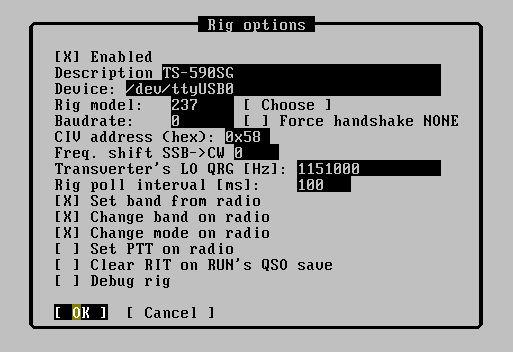
Autosave

It sets and saves parameters of QSO to disk. Option `Save to disk after QSO' is recommended set to 1 to save all reports. Fsync option immediately saves QSOs from cache to disk.
Default setting of option Save to floppy after QSO is 4. Zero disables saving to floppy disk. Path to floppy item sets path to floppy's mount point. Tucnak don't test if floppy disk is mounted.
Other items are ignored.
Network & trace

Ignore interfaces - list of network interfaces which would be ignored for searching next copy Tucnaks on the net (transmit broadcasts) as connect to Internet, public IP address from provider, AX.25 interface. The delimiter between interfaces is space character. Broadcasts loads slow nets.
Ignore networks - the purpose this option is the same as Ignore interface option. You can determinate subnet address.
Announce to nets - it's an inverse function of previous options. There is specification of IP address where have been sending broadcasts in this option. The routers usually have disabled forward broadcastings.
Miscellaneous options

Terminal options

Language
Character set
This menu is used for setting characteristic of terminal as window frames. It's legacy of links, I don't have detailed knowledge about these options.
Load cfg from net
It shows addresses of all Tucnaks on the local network. If one is selected you will read his complete configuration (tucnakrc).
Load C_W from net
It loads complete C_W database from selected Tucnak and saves it to ~/tucnak/tucnakcw. In database are saved two newest locators for each callsign.
Save configuration
It saves current configuration to file ~/tucnak/tucnakrc
![{\displaystyle f_{\mathrm {display} }=f_{\mathrm {CAT} }+f_{\mathrm {lo} }[Hz]}](https://wikimedia.org/api/rest_v1/media/math/render/svg/9806ba1e05db362f1778883425cce3bb409c6dc1)
![{\displaystyle t_{\mathrm {mark} }={\frac {1\,200\,000}{\mathrm {speed} }}+500\cdot \mathrm {weight} \ [\mu s]}](https://wikimedia.org/api/rest_v1/media/math/render/svg/cdc5a38b06941541d786dd1e59af26016cf21d1b)
![{\displaystyle t_{\mathrm {space} }={\frac {1\,200\,000}{\mathrm {speed} }}-500\cdot \mathrm {weight} \ [\mu s]}](https://wikimedia.org/api/rest_v1/media/math/render/svg/53cff6520f79610c109e37055495e2abf60ee4b2)